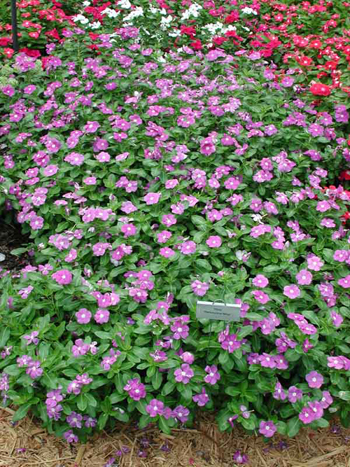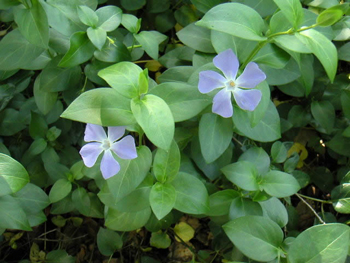Contents:
Common Names | Parts Usually Used | Plant(s) & Culture | Where Found | Medicinal Properties | Biochemical Information
Legends, Myths and Stories | Uses | Bibliography
Scientific Names

- Vinca major L.
- Vinca minor L.
- Apocynaceae
- Dogbane family
Common Names
V. major:
- Great periwinkle
V. minor:
- Early-flowering periwinkle
- Lesser periwinkle
- Running myrtle
Parts Usually Used
The plant
Back to Top

Description of Plant(s) and Culture
Periwinkle is a prostrate, evergreen, creeping plant; the stem bears opposite, dark green, shiny leaves at the joints. During March and April a pale blue flower grows from each stem joint on a long, hollow stalk.
Back to Top
Where Found
Grows wild in Great Britain and Europe and is also cultivated there and in the United States. The pale blue or white flowered plants grow in woods and orchards, hedges, but the purple ones only grow in gardens.
Back to Top
Medicinal Properties
Astringent, sedative, nervine
Back to Top
Biochemical Information
Vincamine
Back to Top
Legends, Myths and Stories
Culpeper tells that the legend has it that if the leaves are eaten by a man and a woman together, it will cause love between them and they will stay in love all their lives.
Both V. major and V. minor make good ground cover, very hardy, thrives in shade. One of the best plants to grow beneath trees and other areas where a carpeting effect is desired. The herb is propagated by root divisions and cuttings.
From several plants of the Vinca family is obtained the drug vinblastine sulfate, now being tested in America for the treatment of Hodgkins’ disease.
Back to Top
Uses
Periwinkle is a remedy for diarrhea, flatulence, indigestion, ulcers in the throat and mouth, diabetes, disorders of the skin and scalp, excessive menstruation and hemorrhage. Chew the herb to help stop bleeding in the mouth, nose, and to help toothache. The tea is used for nervous conditions, hysteria, and convulsions. Improves blood flow in cerebral arteriosclerosis and can be helpful after a stroke; tonic for the cerebral arterioles, reduces high blood pressure, a blood tonic.
Back to Top
Bibliography
![]() The Complete Medicinal Herbal
The Complete Medicinal Herbal, by Penelope Ody, Dorling Kindersley, Inc, 232 Madison Avenue, New York, NY 10016, First American Edition, copyright 1993
![]() Culpeper’s Complete Herbal & English Physician: Updated With 117 Modern Herbs
Culpeper’s Complete Herbal & English Physician: Updated With 117 Modern Herbs, by Nicholas Culpeper, Meyerbooks, publisher, PO Box 427, Glenwood, Illinois 60425, 1990, (reprint of 1814)
![]() The Herb Book
The Herb Book, by John Lust, Bantam Books, 666 Fifth Avenue, New York, NY. copyright 1974.
 The Magic of Herbs
The Magic of Herbs, by David Conway, published by Jonathan Cape, Thirty Bedford Square, London, England. (Out of print)
![]() Webster’s New World Dictionary
Webster’s New World Dictionary, Third College Edition, Victoria Neufeldt, Editor in Chief, New World Dictionaries: A Division of Simon & Schuster, Inc., 15 Columbus Circle, New York, NY 10023
 The Rodale Herb Book: How to Use, Grow, and Buy Nature’s Miracle Plants (An Organic gardening and farming book)
The Rodale Herb Book: How to Use, Grow, and Buy Nature’s Miracle Plants (An Organic gardening and farming book), edited by William H. Hylton, Rodale Press, Inc. Emmaus, PA, 18049., 1974
